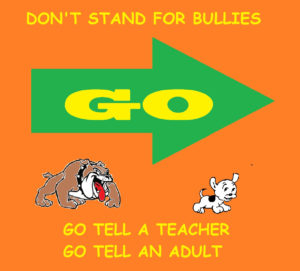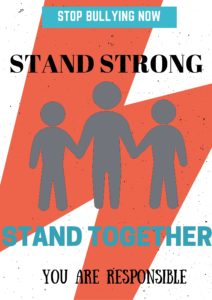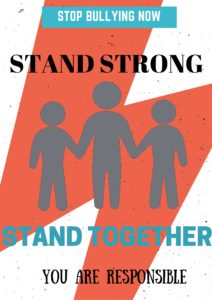Natalie Larimer created this digital story in Documentary Video Challenge: Digital Storytelling for Social Justice, a 2017 J-term course taught by Professor Sandra Patton-Imani, Department for the Study of Culture and Society, Drake University.
Category: Digital Storytelling (Page 2 of 6)
https://youtu.be/UIoCJiKWKy0
Jacob McKay created this digital story in the Drake University J-term class SCS 153: Documentary Video Challenge: Digital Storytelling for Social Justice.
In order to better understand bullying and intervention from a kids perspective I interviewed 13 school aged children. They were elementary, middle, and high school students. The first question I asked them was what is bullying. They all identified bullying as harmful behavior that one person does to another. Some specified that it could include either physical or verbal abuse and most said that it was something that happened repeatedly. Over half of them had seen bullying or had been bullied themselves.
Next, I asked what they saw adults doing about bullying. Almost all of the children said teachers do step in and help and often kids are sent to the guidance counselor or the principle’s office but a few said they did not take it seriously enough. A high schooler noted that teachers seem to take a less active role in intervening with kids in high school than they did in middle or elementary school. Her thought was that adults assumed that high schoolers should know how to deal with it by now but she expressed that many of them do not and that they still need help from adults.
When asked if kids had a job in stopping bullying nearly all of the children said “yes”. The ways they said kids should help is to step in and tell the bully to stop or tell a teacher. Or if they are being bullied themselves they should just ignore it. Of those who weren’t really sure what the kids job was one said they didn’t know what to do to stop it and one said she never gets involved if she sees bullying because she is afraid. One spoke very highly of peer intervention and said he thought kids could probably do a better job of handling a bullying incident than adults because they can just tell the kid to “knock it off” and that usually stops the problem quickly. Over half of the kids said they have stepped in on behalf of another being bullied, either by telling the bully to stop, talking it out with the two involved or telling a teacher. Six of them specifically said their intervention stopped the bullying behavior in that particular instance. However, one girl pointed out that not everyone stands up for themselves or for others being bullied. She says it takes a strong, confident person to do it. There are kids who don’t have this inner strength and that is evident in the one girl who said she never gets involved when she sees bullying because she is afraid the bully will attack her, and another girl who said she is often reluctant to step in because not only could you make the bully mad but all of their friends too.
Bullying in today’s school systems have been drastically affected by the increasing actions of bystandards. In a recent study done by the University of Turku in Finland, it was found that the most consistant way to reduce or even completely stop a child from being bullied is bystandards intervening for other children. It is found to work so well in the dissolvement of bullying because not only does it give confidnece and a sense of protection to the child being bullied, but it also allows the bully to see what he/she is doing wrong. Going back on what i talked about earlier, education is key to young kids. Once children understand that bullying is wrong and see what is looks like, they will be able to stop the problem at the source and stop any other kids from getting bullied also.
The next question was, could adults be doing anything more to help. The majority said they thought adults should intervene and take care of the problem right as it is happening; too often it doesn’t get addressed right away. One suggested that teachers should take the two parties aside and talk it out with them. Another thought there should be more supervision at recess and and in the halls; places where bullying usually occurs.
Finally, I asked who’s job they thought it was to stop bullying. I got an array of answers: parents of the bullly, teachers, the bully, the one being bullied, peers and 2 said it was everyones job. I think these answers show that kids can see there are many people involved in the issue. Kids can help at times but they need all the adults around them to help too. That is why it is important to send the message that everyone plays a role in stopping this problem and everyone has to be active to make a difference.
The poster is an image of people holding hands with writing that says “Stop Bullying. Stand Strong Stand Together.” This shows that bullying is an important issue that has yet to be solved. “Stand Strong Stand Together” offers a solution to bullying by sticking up for each other and everyone being involved. The people holding hands are different sizes because it is not just students that must stick up for each other and stop bullying but it is parents, teachers, students, and the community alike to stick together to be stronger than a bully. This poster is really trying to target everyone that we are friends with on social media. Past teachers, family members, peers, and younger compatriots that we have encountered. We hope this will leave a lasting impact on them to show that people who are bullied are not alone and that just sticking together to solve the bullying problem can be the best solution.
Intervention
By: Anna Burns, Katrena Gillis, Eric Olsen, and Marial Williams
The landscape of bullying has really begun to evolve over recent years, with more traumatic stories of children’s mistreatment by their peers popping up all over the news. Bullying was once given little thought, but has been thrust into the bright spotlight, riddled with stories of child suicide swirling about. While bullying may not be one hundred percent preventable, there are preventative actions that can thwart the current onslaught of bullying. Intervention is the answer, stopping both current bullying and inhibiting its spread.
When it comes to bullying, intervention is essentially coming between the bully and the bullied to end their negative relationship to one another and to keep future bullying from happening. There are many different ways to intervene, and intervention techniques can vary depending on the intervening individual and the type of bullying that is being addressed. When digging deeper into strategies to implement to promote intervention there are several ideas to realize. Several pro-intervention programs are trying to be implemented, but some have a tendency to be short-sighted and are more of a blanket approach aimed at helping the majority of bullying situations. This causes numerous instances of bullying to continue without the proper help. Bullying is also a changing subject that can no longer be pinned to a couple of methods like name calling. Especially with the growth of the internet and social media bullying has grown to take on many new forms. Our society at large also needs to realize the vital role that everyone plays in combating bullying. The struggle is no longer on the shoulders of the victims alone, but all people need to discover that they have influence and can decrease the amount of future bullying.
A variety of tactics could change the setting of bullying for the better. Specifically a feminist social justice approach – a full societal overhaul – would empower more people to see the causes of bullying around them. Fundamentally, people would think differently in bullying situations, rather than relying on male-centered ethics like the current norm. In fact, much of today’s bullying stems from young boys trying to assert their masculinity over each other. If society changed the environment males grow up in, a lot of this bullying would be stopped. Individuals would handle situations in a far different frame of mind, resulting in a much more pro-active approach to managing bullying. People would be better equipped at analyzing situations before acting, thus being better at weighing outcomes, and therefore would be less likely to engage in bullying.
One of the most important things to realize when dealing with bullying today is that there are many programs already in place set to deal with bullying. Unfortunately, as films such as, “Bully” show, the administration that oversees bullying incidents either acts inappropriately toward resolving the conflict or does not hear about the instance. The administration in some situations make the bullying worse than before, leaving the victims with fewer options than before. This is where it is important to know that everyone plays a part in the fight against bullying. Parents need to take initiative with their children’s administration if they feel that the administration’s intervention is not working. Administration’s failure to promote intervention in bullying happening within their domain is preventable, and parents, students, and society should take the necessary steps to cease ongoing bullying.
In the readings, Pascoe talked about homophobic bullying and how society’s views of gender identities has played a large part in creating a mentality that anyone who does not fit the identity has a problem. Boys who do not have enough masculinity in their classmate’s eyes may be bullied for being feminine. If society would see feminine qualities as equal to masculine qualities, a lot of this type of bullying would go away.
Michel Foucault also talks about society’s views in saying that society creates what is normal and abnormal. Part of society’s view of normal is the white heterosexual male. This is definitely not a category that everyone fits into, and that is a cause of nearly every type of bullying of those who are considered different. It would help stop bullying if society would stop labeling things as normal and abnormal, and if society would stop seeing “abnormal” as the same thing as having something wrong with you. Looking at the larger picture of bullying, changing society’s views could be the answer. If society learns to accept others, children should follow.
In the movie, “Bully” it was apparent that either the administration did not recognize the problem, or they did not know how to handle it. Part of this could be that the administration is made of “normal” white heterosexual males. What could help the administration is if they had more empathy towards bullying targets. To do this they could educated themselves further on the struggles of others. To understand women’s struggles better they could read, “A Day without Feminism.” To understand those who are disable more clearly they could read, “Smashing Icons: Disabled Women and the Disability and Women’s Movement.” With more empathy, they would be more inclined to help.
As adults in the school, the teachers play an important part in bullying. They are the closest to students and have the best chance at seeing bullying going on. Teachers should watch for even the slightest signs of bullying and intervene immediately. In addition, students should feel like they can come to the teacher with any of their problems. To make kids feel comfortable coming to them, teachers should have an inclusive and unbiased classroom. For example, there should not be gender roles in the classroom. In Rotundo’s “Boy Culture” he discusses the different lives that boys get to lead over girls. Teachers should not allow these sorts of distinctions or double standards between students.
Parents play one of the largest parts in bullying. As parents, they are the most trusted adults in a child’s life. This is important for parents to remember, especially if they want their kids to come to them for help. Similar to teachers, parents should not perpetuate stereotypes by encouraging things like that discussed by Rotundo in “Boy Culture.” They should not necessarily ignore their boys’ complaints of bullying by telling them to “toughen up,” or to fight their bully.
When it comes to bullying there is not a lot that can be done by children themselves, other than to not bully each other in the first place. The best that those who are bullied can do is let adults know, and educate their peers on their own “different” situation. They can also have less self-hate and self-judgment. In “Black Beauty and Black Power” bell hooks talks about something called “internalized racism.” What she is talking about is our self-judgments that are based off of what society tells us to be true. Kids should recognize when they are judging themselves for something they should and can actually change (e.g. a behavior like laziness) and when they are judging themselves for something that they can not and should not have to change (e.g. their hair color or a disability).
Obviously, as bullying is a large and versatile issue there is not one answer to combatting it. Everyone plays a role in stopping bullying, and it is just a matter of figuring out what can be done to help. Our visual presentation is quick, easy way for people to find out what they can do to help depending on what their relationship is to bullying.

Intervention
Posted by Eric Olsen, Marial Williams, Anna Burns, Katrena Gillis at Friday, May 22, 2015 4:39:07 PM CDT
Intervention is defined as the act of coming between as to prevent or alter a future course of events. Throughout the movie Bullying, both child and parents try their best at intervening in some shape or form, usually with little changing. Even involving the administrators of the children, the people specifically set in charge of dealing with bullying situations were not able to prevent or change the circumstances that plagued these bullied children. The degree to which intervention is implemented in schools, of any age where bullying exists, is to create programs that foster anti-bullying and reason with their students on how their actions impact their fellow classmates. This is especially vital in cases of sexual orientation or disabilities where bullying runs rampant and rarely gets prevented. The culture of these institutions needs to be reformatted to include anti-bullying programs to best ensure their students a safe and loving educational environment.
At its core, social justice is the view that everyone deserves equal economic, political and social rights and opportunities. In regards to bullying, this creates a much more holistic approach that is unfortunately very difficult to maintain and implement. Social justice requires people, in this case adolescents, to see the differences in the people around them and treat all people with the same level of respect and dignity. Currently, children perceive the differences in their peers around them and act on them, resulting in bullying. Children want to feel important and special over the people around them and are willing to achieve this standard, even if it means ridiculing their classmates. If social justice was implemented and accepted, children would understand the effect their words/actions have and would improve virtually every aspect of bullying. With this approach not only would current bullying cease, it would prevent future bullying from happening due to everyone involved understanding the consequences for their actions.
An approach like this would also require a major shift in the views of society. Masculinity has been so ingrained into our society that bullying, to some extent, has been encouraged. It is considered masculine to be dominant and aggressive over those around you. Changing the landscape of bullying would require younger boys to realize that bullying is not the outlet to channel these masculine tendencies, but rather through other outlets like sports or hobbies. Exerting your ability in a hobby is far less harmful than showing your power in degrading another human being. While this will not be easy, through the right programs and determination boys can be changed and can learn that bullying is not a healthy path for anyone.
Social justice directly affects intervention because it teaches all parties involved to be active in confronting the bullying around them. Everyone ‘buys-in’ and takes responsibility for their actions in creating an equal environment for all, refusing to let injustices prevail. A social justice system would also likely be effective, if all accepted, due to its easy conversion to a broad range of factors that involve bullying like sexuality, race, or class. In essence, intervention would no longer be needed because bullying would be eliminated, after the system was in place. However, in the developing stages of a social justice system, intervention would be encouraged from a variety of sources, empowering those to act on the differences they observe.



Recent Comments